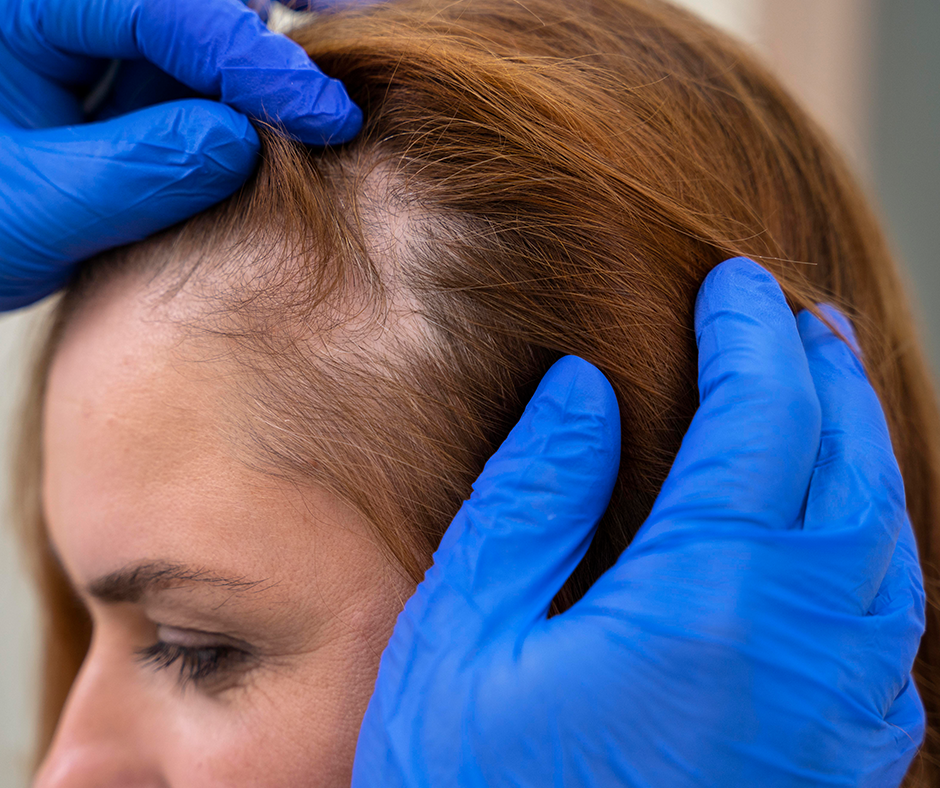When we hear the word “baldness” the most common is to relate this condition to middle-aged men. However, teenagers as well as middle-aged women also suffer from alopecia, and its effects are equally traumatic as silky, long, shiny and abundant hair are synonymous with feminine beauty.
Hair loss affects men and women equally; although it is less frequent in women, female pattern alopecia has received little attention from society and science, probably because they have more options for hairstyles, wigs and accessories such as hats to disguise hairless spaces. However, bald men are socially recognized and accepted, while bald women are often discriminated.
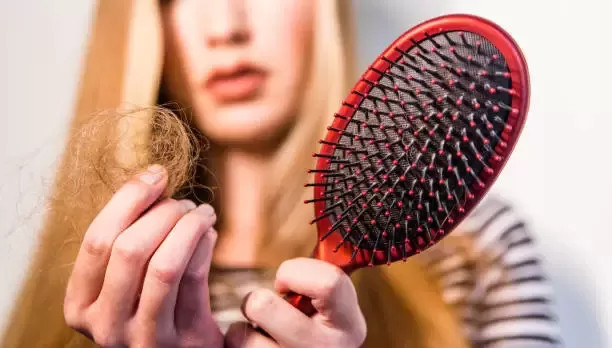
Tabla de Contenidos
What is alopecia?
Alopecia means hair loss; although it is usually related to the word baldness, this term is not correct, since it excludes conditions that cause loss of capillary density, but not a situation of obvious fall, as in the case of female alopecia.
Women androgenic alopecia is known as female pattern alopecia (FPA) because it has its own characteristics, etiological and clinical peculiarities, evolution and treatment that differentiate it from the conditions that affect men.
FPA is a type of non-scar alopecia, which occurs in women slowly and progressively, affecting capillary density and the scalp. In this condition, the anagen-telogen cycle is minimized, so that follicular cycles produce shorter, smaller-diameter hair because the follicles are miniaturized and, in more advanced stages, invisible. That is, the follicles are still present in the female scalp, but in an atrophic state.
In female alopecia, genetic factors and hormonal alterations are involved due to male hormones known as androgenic, which gives the name of androgenic alopecia. However, the genetic relationship and the presence of androgens is not clear, since both factors are not present in all cases.
FPA is the most frequent hair loss form in women, affecting more than 50% throughout their lives being more frequent starting at 50 years of age, although in some cases the process begins at puberty or around 30 years.
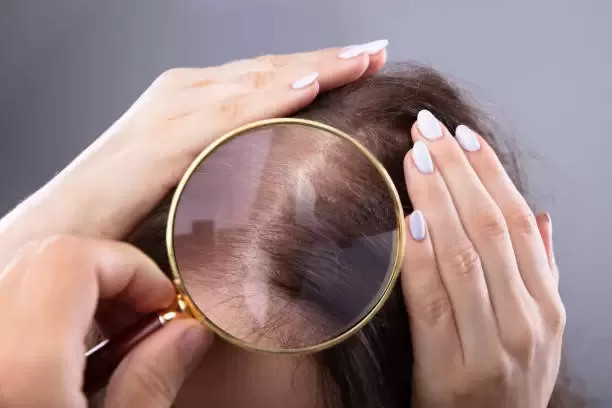
Types of alopecia in women
- Androgenic alopecia. It is estimated that about 30% of women with FPA have signs of hyperandrogenism, an excess of male hormones, with other clinical manifestations such as facial hair or hair in areas such as the chest or arms, acne resistant to treatment, galactorrhea, infertility or menstruation alterations.
- Telogen effluvium or “stress hair loss”. Diffuse and abundant hair loss in localized and generally circular areas that may be due to poor diet, stress, depression, due to the action of certain medications that are consumed constantly (heparin, antiretrovirals, aspirin, among others), chronic diseases such as diabetes and autoimmune pathologies. Although this type of alopecia affects men and women, it usually has a higher incidence in women, although it can be completely reversed with the appropriate treatment.
- Alopecia areata. This condition is related to autoimmune diseases, in which the body attacks and destroys healthy hair follicles; in women it is very common after a pregnancy, where a cycle of hair loss in strands begins, but that ceases on its own after a few months, and the hair grows back, although slowly.
- Fibrosing frontal alopecia. It is a type of scar alopecia, which causes hair follicle destruction and usually occurs in the postmenopausal stage, mainly affecting the headband area.
- Traction alopecia. Hair loss that occurs due to a constant overstretching of the hair, which happens when wearing grabbed hair and tightened hairstyles, which can cause permanent hair loss by damaging the hair follicles.
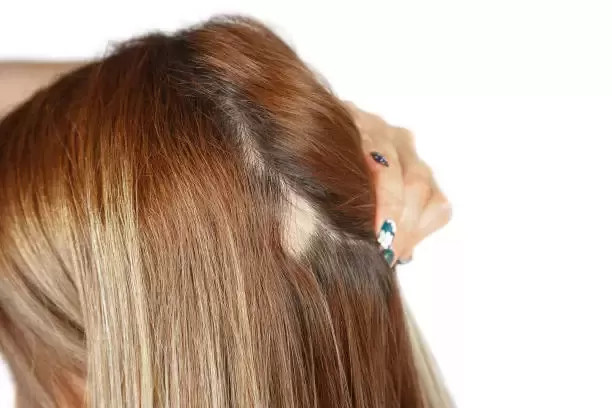
Baldness and alopecia, is there a difference?
In general, the terms baldness and alopecia are used synonymously. However, alopecia is the term to describe different types of diseases and conditions that cause hair loss both on the scalp and in other parts of the skin where there is hair, such as eyelashes, eyebrows, beard, among others.
Alopecia is classified into two groups; scarring in which hair follicles are destroyed and, therefore, hair loss is irreversible. Or, non-scarring alopecia in which the fall is slowed down and is potentially reversible. The most common alopecia is androgenic, which is the main cause of common baldness, since it is estimated to be responsible for 95% of cases.
What are alopecia causes in women?
Genetics and heredity
FPA causes are similar to those affecting men; hormonal and genetic factors are considered; the hereditary component is important since a gene related to alopecia has been found in the chromosomes.
Hormonal changes
Regarding the hormonal factor, women produce androgens in three organs: adrenals, ovaries and non-endocrine tissues such as the skin. The testosterone produced by the female organism is transformed into dehydrotestosterone, which exerts a reducing action of estradiol, a female hormone and forms an activated complex that enters the cell nucleus and causes the sebaceous glands to increase in size as well as increasing their secretory activity, while causing the miniaturization of the follicle. In short, this process causes an increase in fat in the scalp, which subtracts nutrients from the follicles, weakens them and kills them little by little.
Therefore, menopause is a stage in which female alopecia occurs due to hormonal imbalances caused by low estrogen and an increase in male hormones or androgens.
Diseases
- Alopecia areata. An autoimmune disease in which white blood cells attack hair follicles to disrupt hair growth and cause hair loss. In addition to causing hair loss on the head, it usually affects the eyebrows and eyelashes, leaving free hair “patches”.
- Lupus. Another autoimmune disease that affects many systems and organs in the body, hair loss being one of the manifestations.
- Type 2 diabetes mellitus. Excess blood sugar levels interact with red blood cells, causing the synthesis of a compound called glycosylated hemoglobin, which deforms red blood cells and makes them stiffer than normal, causing them to get stuck between the walls of the blood vessels. This obstruction is responsible for circulatory and vascular problems, so the follicles do not receive the nutrients they need to grow healthy and fight bacterial and fungal infections.
- Anemia. Iron deficiency can cause hair loss, slow growth, as well as fragile and brittle hair.
- Tinea capitis. This disease caused by Microsporum and Trichophyton fungi which causes scaling on the scalp, changes in color to a gray tone, a lot of itching on the scalp and inflammation. It is very contagious and it is essential to visit the doctor in case of detecting symptoms.
- Sexually transmitted diseases. HIV and syphilis infections cause hair loss in some cases.
- Hypothyroidism. One of the symptoms of this autoimmune disease, which is characterized by the fact that the thyroid gland produces low levels of T3 and T4 hormones, and there´s hair loss in large quantities affecting the scalp and the body in general. This is because one of the functions of thyroid hormones is the regulation of hair cycles.
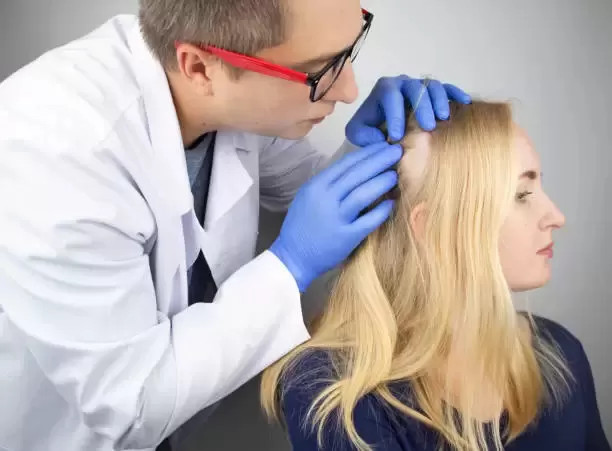
Postpartum hair loss
Postpartum alopecia is temporary hair loss that occurs 2 to 3 months after childbirth. Many women associate it with breastfeeding, but the reality is that it is caused by the hormonal changes typical of this stage in which estrogen and iron decrease, coupled with stress and inadequate nutrition that new mothers tend to have.
In addition, there is a physiological condition that accelerates hair loss after childbirth: telogen effluvium, which is the resting phase in which hair does not grow and falls out easily.
Lifestyle
Some lifestyle habits are related to hair loss: the extreme use of chemical products for hair bleaching, using the flat iron daily, in addition to tobacco consumption that decreases blood flow and nutrients transportation to the hair follicles. In addition, very stretched hairstyles that pull hair from the root, such as African braids or ponytails, cause what is known as traction alopecia.
Risk factors
- Family background
- Advanced age
- Overweight and obesity
- Nutritional deficiencies
- Smoking
- Cancer treatments
- Stress periods
Symptoms of alopecia in women
- Gradual hair loss on the top of the head. This is the most common form in women, and usually occurs in women after menopause, who notice a widening in the hairline, or a receding hairline on the forehead.
- Irregular or circular patches. Some women lose their hair in patches, a situation that is usually accompanied by itching or pain in the skin before it falls out.
- Hair loosening. This is usually caused by stress or depression situations: women notice that hair strands fall out when combing or bathing, even when pulling it gently.
- Hair loss from other parts of the body. On some occasions, hair loss is accompanied by loss of eyebrows, hair on arms or legs, even eyelashes.
- Finding many hairs on the pillow when getting out of bed
- Losing a lot of hair while showering
- Loss of hair density
- Noticing “receding lines” on the forehead or hollows on the top of the head
- Notice that the hairline is separating more and more
If you notice inflammation, burning and redness on the scalp, you should visit a doctor immediately to rule out another condition.
Diagnosis
It is essential to go to a specialist to diagnose the cause of alopecia in women: either temporarily after childbirth, due to an autoimmune disease, or detect FPA in time and treat it before it leaves serious consequences.
The specialist will make an extensive medical history and may require hormonal, blood chemistry, and thyroid factors to rule out other conditions.
What is “female pattern baldness”?
When it comes to androgenic alopecia, hair loss is usually different in women and men. The female pattern consists of thinning hair along the crown of the scalp, which causes a loss of density and volume in the mane.
Treatment
FPA treatment involves a multidisciplinary action in which etiological factors, cosmetic care and hair strengthening are considered. The most common are:
- Topical treatments. Drugs such as minoxidil, cyproterone acetate or finasteride stimulate hair growth but must be administered by professionals as some are contraindicated in pregnancy or lactation cases. In addition, these treatments do not always give results when applied without medical indication and can worsen hair loss.
- Vitamin supplements. In some cases, iron, zinc, biotin, vitamin B supplementation among others, helps treat nutritional deficits, in addition to strengthening the hair and improving the skin appearance.
- Women hair transplant in Tijuana. The definitive and proven solution to combat the effects of alopecia. It is an invasive method that requires professional attention with follicles micro grafting techniques containing one to three hairs to cover the affected areas.
- Others. Hair mesotherapy, Platelet Rich Plasma, growth factors are some treatments that nourish the follicles, stimulate growth and strengthen the hair to restore its health and shine.

Is hair loss in women preventable?
Although autoimmune diseases and androgenic alopecia are the main causes of hair loss, some recommendations can help you take care of your hair and suffer as little as possible:
- Maintain a healthy diet
- Visit the doctor regularly
- Consume vitamins if you need them
- Avoid extreme use of hair irons, hot water and chemical bleaching treatments.
- Avoid extreme sun exposure
Home care is also important
Home care is important in order to prevent hair loss and maintain healthy, shiny and beautiful hair. The recommendations are:
- Wash hair with warm water
- Use products that are friendly to your scalp, that clean and do not clog pores
- Scalp massages
- Use hair masks at least once a week
- Comb the hair gently and avoid hairstyles that pull out the hair.
At Hairfix you will find the specialists you need. We have the best technology and highly trained specialists with extensive experience in hair implants Tijuana, hair grafting, the permanent solution to recover the density of your hair. Contact us today to schedule a personalized assessment appointment. We will gladly assist you! Ask us about hair transplant cost Mexico.

